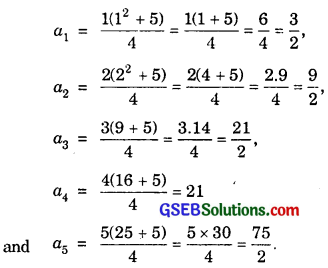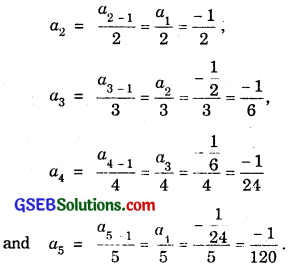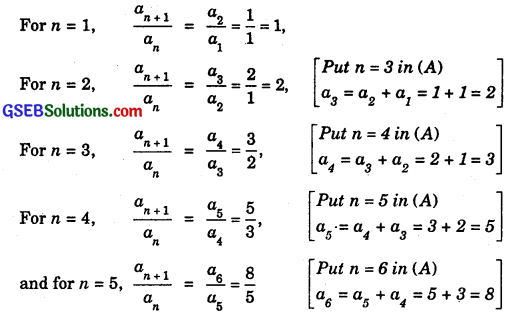Gujarat Board GSEB Textbook Solutions Class 11 Maths Chapter 9 Sequences and Series Ex 9.1 Textbook Questions and Answers.
Gujarat Board Textbook Solutions Class 11 Maths Chapter 9 Sequences and Series Ex 9.1
Write the first five terms of each of the sequences of questions 1 to 6 whose nth terms are:
Solutions to questions 1 – 6:
1. an = n(n + 2)
2. an = \(\frac{n}{n+1}\)
3. an = 2n
4. an = \(\frac{2n-3}{6}\)
5. an = (- 1)n-15n+1
6. an = \(\frac{n\left(n^{2}+5\right)}{4}\)
Solution to questions 1 – 6:
1. an = n(n + 2)
Putting n = 1, 2, 3, 4 and 5, we get
a1 = 1(1 + 2) = 1.3 = 3, a2 = 2.(2 + 2) = 2.4 = 8,
a3 = 3(3 + 2) = 3.5= 15, a4 = 4.(4 + 2) = 4.6 = 24 and
a5 = 5(5 + 2) = 5.7 = 35.
∴ The first of five terms of the sequence, whose nth term is
an = n(n + 2) are 3, 8, 15, 24 and 35.
![]()
2. an = \(\frac{n}{n+1}\)
Putting n = 1, 2, 3, 4 and 5, we get
a1 = \(\frac{1}{1+1}\) = \(\frac{1}{2}\), a2 = \(\frac{2}{2+1}\) = \(\frac{2}{3}\),
a3 = \(\frac{3}{3+1}\) = \(\frac{3}{4}\), a4 = \(\frac{1}{4+1}\) = \(\frac{4}{5}\)
and a5 = \(\frac{5}{5+1}\) = \(\frac{5}{6}\).
∴ The first five terms of the sequence whose
nth term is \(\frac{n}{n+1}\) are \(\frac{1}{2}\), \(\frac{2}{3}\), \(\frac{3}{4}\), \(\frac{4}{5}\) and \(\frac{5}{6}\).
3. an = 2n. Putting n = 1, 2, 3, 4 and 5, we get
a1 = 21 = 2, a2 = 4, a3 = 23 = 8,
a4 = 24 = 16 and a5 = 25 = 32.
∴ Required first five terms of the sequence are 2, 4, 8, 16 and 32.
![]()
4. Here, an = \(\frac{2n-3}{6}\).
Putting n = 1, 2, 3, 4 and 5, we get
a1 = \(\frac{2×1-3}{6}\) = \(\frac{2-3}{6}\) = \(\frac{-1}{6}\);
a2 = \(\frac{2×2-3}{6}\) = \(\frac{4-3}{6}\) = \(\frac{1}{6}\);
a3 = \(\frac{2×3-3}{6}\) = \(\frac{6-3}{6}\) = \(\frac{3}{6}\) = \(\frac{1}{2}\);
a4 = \(\frac{2×4-3}{6}\) = \(\frac{8-3}{6}\) = \(\frac{5}{6}\)
and a5 = \(\frac{2×5-3}{6}\) = \(\frac{10-3}{6}\) = \(\frac{7}{6}\).
5. an = (- 1)n-15n+1
a1 = (- 1)0.5i+1 = 52 = 25,
a2 = (- 1)2-1.52+1 = – 53 = – 125,
a3 = (- 1)3-1.53+1 = 51 = 625,
a1 = (- 1)4-1.54+1 = – 55 = – 3125,
and a5 = (- 1)5-1.55+1 = 56 = 15625.
The first five terms of the given sequence are
25, – 125, 625, – 3125 and 15625.
6. an = \(\frac{n\left(n^{2}+5\right)}{4}\)
Putting n = 1, 2, 3, 4 and 5, we get

∴ The first five terms are \(\frac{3}{2}\), \(\frac{9}{2}\) \(\frac{21}{2}\), 21 and \(\frac{75}{2}\).
![]()
Find the indicated terms in each of the following sequences in questions 7 to 10 whose nth terms are
7. an = 4n – 3; a17, a24
8. an = \(\frac{n^{2}}{2^{n}}\); a7
9. an = (- 1)n-1n3, a9
10. \(\frac{n(n-2)}{n+3}\); a20
Solutions to questions 7 to 10:
7. an = 4n – 3, Putting n = 17 and 24, we get
a17 = 4.17 – 3 = 68 – 3 = 65
and a24 = 4.24 – 3 = 96 – 3 = 93.
8. an = \(\frac{n^{2}}{2^{n}}\); a7 Putting n = 7, we get
a7 = \(\frac{7^{2}}{2^{7}}\) = \(\frac{49}{128}\).
9. an = (- 1)n-1n3, Putting n = 9, we get
an = (- 1)9-193 = 729.
![]()
10. an = \(\frac{n(n-2)}{n+3}\). Putting n = 20, we get
a20 = \(\frac{20(20-2)}{20+3}\) = \(\frac{20.18}{23}\) = \(\frac{360}{23}\).
Write the first five terms of each of the sequences in questions 11 to 13 and obtain the corresponding series:
11. a1 = 3, an = 3an-1 + 2 for all n > 1.
12. a1 = – 1, an = \(\frac{a_{n-1}}{n}\), n ≥ 2
13. a1 = a2 = 2, an = an-1 – 1, n ≥ 2
Solution to questions 11 to 13:
11. a1 = 3, an = 3an-1 + 2.
Putting n = 2, 3, 4 and 5, we get
a2 = 3a1 + 2 = 3.3 + 2 = 9 + 2 = 11,
a3 = 3a2 + 2 = 3.11 + 2 = 33 + 2 = 35,
a4 = 3a3 + 2 = 3.35 + 2 = 105 + 2 = 107.
and a5 = 3a4 + 2 = 3.107 + 2 = 321 + 2 = 323.
The first five terms of the sequence are 3, 11, 35, 107 and 323.
∴ The corresponding series is 3 + 11 + 35 + 107 + 323 + ……………..
![]()
12. Here, a1 = – 1, an = \(\frac{a_{n-1}}{n}\), n ≥ 2.
Putting n = 2, 3, 4, 5 and 6, we get

∴ The first five terms of the sequence are – 1, – \(\frac{1}{2}\), – \(\frac{1}{6}\), – \(\frac{1}{24}\) and \(\frac{- 1}{120}\).
The corresponding series is – 1, – \(\frac{1}{2}\) – \(\frac{1}{6}\) – \(\frac{1}{24}\) – \(\frac{1}{120}\) – …………………
13. Here, a1 = a2 = 2, an = an-1 – 1 (n > 2)
Putting n = 3, 4, 5, 6 and 7, we get
a3 = a3-1 – 1 = a2 – 1 = 2 – 1 = 1;
a4 = a4-1 – 1 = a3 – 1 = 1 – 1 = 0;
a5 = a5-1 – 1 = a4 – 1 = 0 – 1 = – 1;
The first five terms of the sequences are 2, 2, 1, 0 and – 1.
The corresponding series is 2 + 2 + 1 + 0 – 1 + …………………
![]()
14. The fibonacci sequence is defined by 1 = a1 = a2 and an = an-1 + an-2, n > 2.
Find \(\frac{a_{n+1}}{a_{n}}\) for n = 1, 2, 3, 4 and 5.
Solution:
Here, a1 = 1 = a2 and an = an-1 + an-2 (n > 2) …………….. (A)

The values of \(\frac{a_{n+1}}{a_{n}}\) for n = 1, 2, 3, 4 and 5 are respectively 1, 2, \(\frac{3}{2}\), \(\frac{5}{3}\) and \(\frac{8}{5}\).